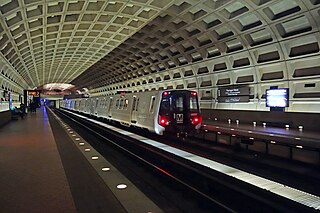
The Washington Metro, often abbreviated as the Metro and formally the Metrorail, is a rapid transit system serving the Washington metropolitan area of the United States. It is administered by the Washington Metropolitan Area Transit Authority (WMATA), which also operates the Metrobus service under the Metro name. Opened in 1976, the network now includes six lines, 98 stations, and 129 miles (208 km) of route.
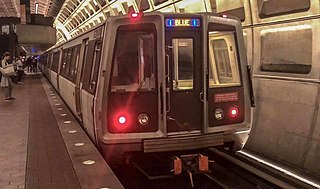
The Blue Line is a rapid transit line of the Washington Metro system, consisting of 28 stations in Fairfax County, Alexandria and Arlington, Virginia; Washington, D.C.; and Prince George's County, Maryland, United States. The Blue Line runs from Franconia–Springfield to Downtown Largo. The line shares track with the Orange Line for 13 stations, the Silver Line for 18, and the Yellow Line for 7. Only 3 stations are exclusive to the Blue Line.

The Red Line is a rapid transit line of the Washington Metro system, consisting of 27 stations in Montgomery County, Maryland, and Washington, D.C., in the United States. It is a primary line through downtown Washington and the oldest and busiest line in the system. It forms a long, narrow "U," capped by its terminal stations at Shady Grove and Glenmont.

The Green Line is a rapid transit line of the Washington Metro system, consisting of 21 stations in Washington, D.C., and Prince George's County, Maryland, United States. The Green Line runs from Branch Avenue, to Greenbelt, connecting the southeast suburbs to the northeast suburbs through downtown Washington, DC.

The Yellow Line is a rapid transit line of the Washington Metro system that runs between Huntington in Virginia and Mount Vernon Square in Washington, D.C. It consists of 13 stations in Fairfax County, the city of Alexandria, and Arlington County in Virginia, and Washington, D.C. It is the shortest line in the system, and since its truncation to Mount Vernon Square, it is the only line that does not enter Maryland.

Takoma station is a Washington Metro station on the Red Line in the Takoma neighborhood of Washington, D.C., bordering Takoma Park, Maryland. The station is considered to be located in part of Takoma Park's Historic District. It is the last station in the District of Columbia on the eastern end of the Red Line heading to Maryland, located east of the intersection of Blair Road NW and Cedar Street NW. The station's parking lot and bus stops are accessed from Eastern Avenue NW, which runs along the DC–Maryland line.

Franconia–Springfield station is a Washington Metro rapid transit station and Virginia Railway Express commuter rail station located in Springfield, Virginia, United States. The station is the southwestern terminus of the Metro Blue Line and an intermediate station on the VRE Fredericksburg Line. It is also a major bus terminal for Fairfax Connector buses, plus other local and intercity bus routes. The station has one island-platform serving the two Metro tracks, plus two side platforms serving the RF&P Subdivision on which the Fredericksburg Line runs.

Eisenhower Avenue station is a rapid transit station on the Yellow Line of the Washington Metro in Alexandria, Virginia. It opened on December 17, 1983.

Huntington station is an island-platformed Washington Metro station in the Huntington area of Fairfax County, Virginia, United States. The station was opened on December 17, 1983, and is operated by the Washington Metropolitan Area Transit Authority (WMATA). Serving as the southern terminus for the Yellow Line, the station is built into a hillside; the south mezzanine, along with escalator access, is accessible via an incline elevator.
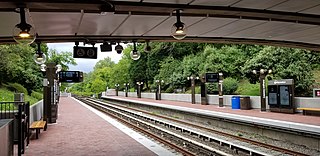
Arlington Cemetery station is a side platformed Washington Metro station in Arlington, Virginia, United States. The station was opened on July 1, 1977, and is operated by the Washington Metropolitan Area Transit Authority (WMATA). The station provides service for only the Blue Line, and is located at the entrance to Arlington National Cemetery, underneath Memorial Drive. There is no public parking near the station except at the cemetery, which is reserved for cemetery visitors. It is the only station that closes earlier than the rest of the system, closing at 7 PM from October to March, and 10 PM from April to September.
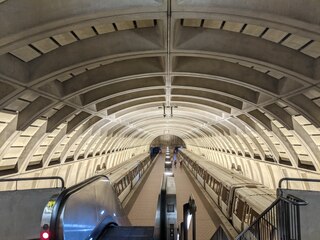
Mount Vernon Square station is a Washington Metro station in Washington, D.C., on the Green and Yellow Lines. It is the northeastern terminus of the Yellow Line.

U Street station is a rapid transit station on the Green Line of the Washington Metro in the U Street neighborhood of Washington, D.C.

Georgia Avenue–Petworth station is a Washington Metro station in Washington, D.C., on the Green Line. It is located at the border of the neighborhoods of Petworth, Sixteenth Street Heights, and Park View in Northwest.

West Hyattsville station is a Washington Metro station in Hyattsville, Maryland on the Green Line. It is the first station in Prince George's County, Maryland northeast on the Green Line, and is located at 2700 Hamilton Street, near the west side of Ager Road and the north side of Queens Chapel Road.

Hyattsville Crossing station is a Washington Metro station in Hyattsville, Maryland, on the Green Line. It opened on December 11, 1993, as Prince George's Plaza, referencing the nearby Prince George's Plaza, now known as The Mall at Prince Georges. The station has a unique layout in that it is an open-cut side platformed station with a parking garage directly over the tracks.

College Park–University of Maryland station is a Washington Metro station in Prince George's County, Maryland, on the Green Line. It also serves MARC's Camden Line, though only select trains stop at the station.

Greenbelt station is a Washington Metro and MARC station in Prince George's County, Maryland. The station is the northeastern terminus of the Green Line of the Washington Metro. MARC commuter rail trains on the Camden Line also stop at Greenbelt on a set of tracks parallel to the Metro tracks.

The Riggs Road Line, designated as Routes R1 & R2, is a daily bus route operated by the Washington Metropolitan Area Transit Authority between Fort Totten station of the Red and Green Lines of the Washington Metro & Adelphi (R1) or Calverton (R2). Routes R1 & R2 operate every 20 minutes during peak hours and route R2 operates every 35-60 minutes at other times on weekdays, and 60 minutes on the weekends. R1 trips are roughly 32 minutes and R2 trips are roughly 55 minutes.
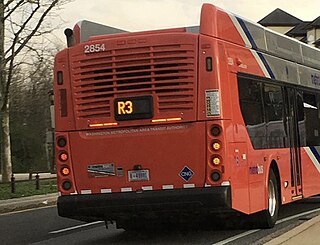
The Greenbelt–Prince George's Plaza Line, designated Route R3, was a bus route that was operated by the Washington Metropolitan Area Transit Authority between Greenbelt station and Prince George's Plaza station of the Green Line of the Washington Metro. The route provided service between the Greenbelt and Hyattsville during the weekday peak-hours. However the route was discontinued due to low ridership on March 27, 2016.
The Takoma–Fort Totten Line designated as Route K2 is a Metrobus Route operated by the Washington Metropolitan Area Transit Authority between the Fort Totten Metro Station of the Red and Green Lines and Takoma Metro Station of the Red Line of the Washington Metro. The line operates every 20 minutes during weekday peak hours only with trips taking 15 minutes to complete.























